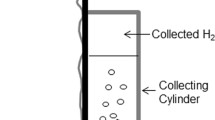Abstract
Electrochemical and electrolyte conditions are explored for galvanostatic and potentiostatic anodization of uranium metal for the purpose of imparting resistance to hydride corrosion. Sulfuric acid, nitric acid, and boric acid mixtures are studied as potential anodization media. It is found that anodization delays the bulk hydride corrosion of uranium in all cases studied by between 1.3 and 3.1 times an unanodized baseline. The most robust extension is found to exist for potentiostatic anodization in concentrated sulfuric acid. These conditions are further found to produce a more uniform hydride corrosion morphology compared to nitric acid or electrolytes with boric acid added.






Similar content being viewed by others
References
Banos A, Harker NJ, Scott TB (2018) A review of uranium corrosion by hydrogen and the formation of uranium hydride. Corros Sci 136:129–147
Venkert A, Aizenshtein M, Arkush R, Shamir N (1996) Stress induced preferential oxidation at the uranium-uranium carbide interface. J Nucl Mater 231(3):254–256
Bazley SG, Petherbridge JR, Glascott J (2012) The influence of hydrogen pressure and reaction temperature on the initiation of uranium hydride sites. Solid State Ionics 211:1–4
Arkush R, Venkert A, Aizenshtein M, Zalkind S, Moreno D, Brill M, Mintz MH, Shamir N (1996) Site related nucleation and growth of hydrides on uranium surfaces. J Alloys Compd 244(1–2):197–205
Harker NJ, Scott TB, Jones CP, Petherbridge JR, Glascott J (2013) Altering the hydriding behaviour of uranium metal by induced oxide penetration around carbo-nitride inclusions. Solid State Ionics 241:46–52
Banos A, Scott TB (2016) Statistical analysis of UH3 initiation using electron back-scattered diffraction (EBSD). Solid State Ionics 296:137–145
Bingert JF, Hanrahan RJ Jr, Field RD, Dickerson PO (2004) Microtextural investigation of hydrided α-uranium. J Alloys Compd 365(1–2):138–148
Hanrahan RJ, Hawley ME, Brown GW (1998) The influence of surface morphology and oxide microstructure on the nucleation and growth of uranium hydride on alpha uranium. In: MRS Online Proceedings Library (OPL), p 513
Slunder CJ (1946) TREATMENT OF URANIUM SURFACES. United States
Stebbens AE, Shreir LL (1961) A study of the formation of anodic oxide films on uranium: I. An optical reflectivity method for determining the kinetics of film growth. J Electrochem Soc 108(1):30
Lundquist JR, Stromatt RW (1965) Nickel electroplating on uranium: surface preparation and plating solution studies (No. BNWL-124). Battelle-Northwest, Richland, Wash. Pacific Northwest Lab
Jiang Y, Fang L, Luo L, Wang X (2018) Fundamental aspects of uranium electropolishing in AlCl3-1-ethyl-3-Methylimidazolium chloride ionic liquid. J Electrochem Soc 165(2):E70
Thompson G, Zhang L, Smith CJE, Skeldon P (1999) Boric/Sulfuric acid anodizing of aluminum alloys 2024 and 7075: film growth and corrosion resistance. Corrosion 55(11):1052–1061
Zhang L, Thompson GE, Curioni M, Skeldon P (2013) Anodizing of aluminum in sulfuric acid/boric acid mixed electrolyte. J Electrochem Soc 160(4):C179–C184
Rigsby MA, Spurlin TA, Reid JD (2020) The multi-functional role of boric acid in cobalt electrodeposition and superfill. J Electrochem Soc 167:112507
Loui A, McCarrick J, McLean W (2021) Uranium hydride corrosion. I new insights into the Condon-Kirkpatrick model of uranium hydride formation rate. Corros Sci 191:109710
Manara D, Renker B (2003) Raman spectra of stoichiometric and hyperstoichiometric uranium dioxide. J Nucl Mater 321(2–3):233–237
Idriss H (2010) Surface reactions of uranium oxide powder, thin films and single crystals. Surf Sci Rep 65(3):67–109
Glascott J (2014) A model for the initiation of reaction sites during the uranium–hydrogen reaction assuming enhanced hydrogen transport through thin areas of surface oxide. Phil Mag 94(3):221–241
Acknowledgements
This work was supported by the U.S. Department of Energy through the Los Alamos National Laboratory. Los Alamos National Laboratory is operated by Triad National Security, LLC, for the National Nuclear Security Administration of U.S. Department of Energy (Contract No. 89233218CNA000001).
Author information
Authors and Affiliations
Corresponding author
Ethics declarations
Conflict of interest
There are no conflicts of interest.
Additional information
Publisher’s Note
Springer Nature remains neutral with regard to jurisdictional claims in published maps and institutional affiliations.
Rights and permissions
Springer Nature or its licensor (e.g. a society or other partner) holds exclusive rights to this article under a publishing agreement with the author(s) or other rightsholder(s); author self-archiving of the accepted manuscript version of this article is solely governed by the terms of such publishing agreement and applicable law.
About this article
Cite this article
Campbell, K., Pital, A., Droessler, J. et al. Effects of anodization conditions on subsequent hydride corrosion of uranium metal. J Radioanal Nucl Chem 332, 809–815 (2023). https://doi.org/10.1007/s10967-023-08774-y
Received:
Accepted:
Published:
Issue Date:
DOI: https://doi.org/10.1007/s10967-023-08774-y



